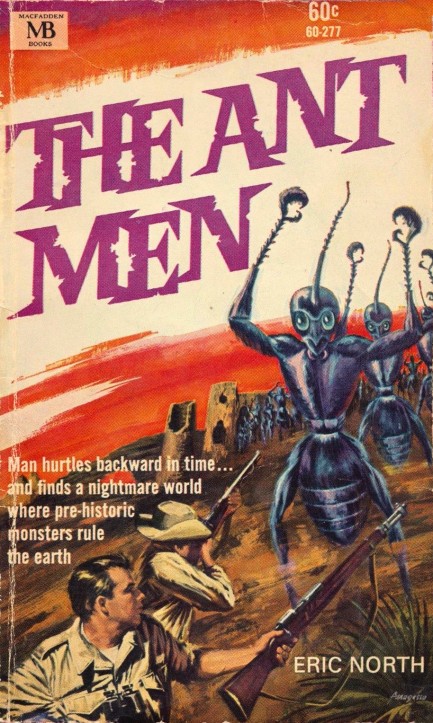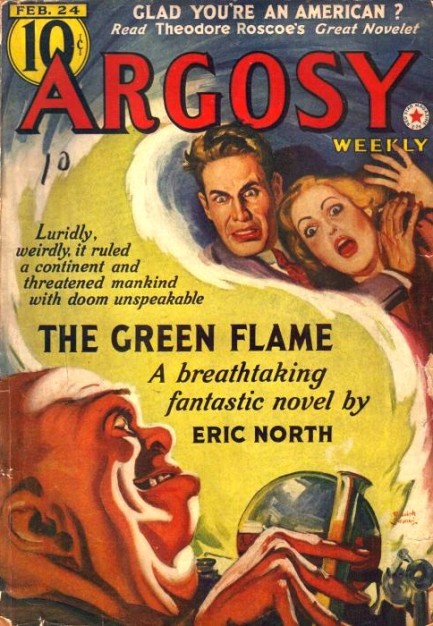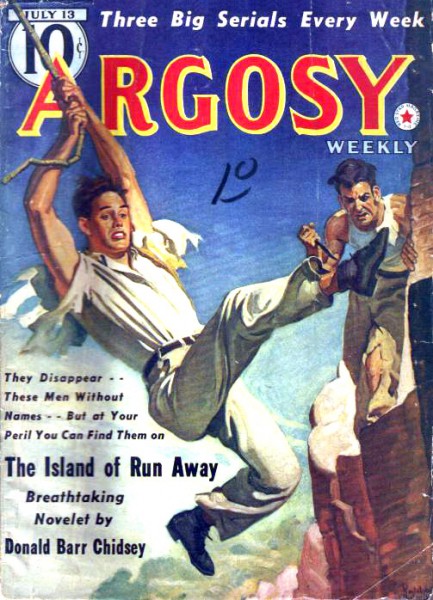 I'm down to my last few bullets! Throw those egg salad sandwiches we brought for lunch! Maybe those will slow them down! 
When we first saw Eric North's 1955 sci-fi thriller The Ant Men the first thought we had— Well, actually, the second thought. The first thought was: “Oh, this is a must read.” Our second thought was: “Highly centralized, conscienceless, conformist hordes seeking to overrun everything in sight? Hmm, wonder what that's a paranoid metaphor for?” But the book doesn't really have the anti-commie thing. It's sci-fi played straight about six unfortunate people who stumble upon a city of giant ants in the dead heart of Australia. To make matters worse, there are more than just ants out there. It's reasonably fun at first, but North slowly drives his own narrative south with an impossibly annoying Aussie bush guide character who exclaims, “Mamma mamma!” probably fifty times. Five would have gotten the idea across. Before long we were hoping the ants would rip him to pieces and drag his sections down a hole to their queen. The fact that they don't is the book's biggest flaw. Aside from that it's decent, but certainly not among the better sci-fi novels of the period. This MacFadden-Bartell edition has art by Jack Faragasso.
 What the heck is an Argosy anyway? 
You know we’re fond of anniversaries around here, so today we have an Argosy that was published seventy-one years ago today, in February 1940. The cover has Rudolph Belarski art, and inside is a slate of pure escapist fiction, from Eric North’s tale of Australian mysticism and adventure “The Green Flame,” to Charles Marquis Warren’s tale “Then I’ll Remember,” set aboard Noah’s Ark. And speaking of arks, in case you’ve wondered, an argosy is a merchant ship laden with an abundantly rich cargo. So it’s a fitting, if obscure, name for a magazine that publishes adventure fiction. As with all our recent Argosys, this one comes from National Road Books, and if you visit their website (edit: now defunct) you’ll find that they’re laden with an abundantly rich cargo as well. Thanks again guys.
 I’m gonna make it! I’m gonna make it! I’m... shit!—not gonna make it! 
Above, a July 1940 issue of Argosy with a Rudolph Belarski cover and fiction from Eric North, Stookie Allen, Jim Kjelgaard and Frank Richardson Pierce. Find this and other issues of Argosy here.
|
 |

The headlines that mattered yesteryear.
1961—Bay of Pigs Invasion Is Launched
A group of CIA financed and trained Cuban refugees lands at the Bay of Pigs in southern Cuba with the aim of ousting Fidel Castro. However, the invasion fails badly and the result is embarrassment for U.S. president John F. Kennedy and a major boost in popularity for Fidel Castro, and also has the effect of pushing him toward the Soviet Union for protection. 1943—First LSD Trip Takes Place
Swiss scientist Albert Hofmann, while working at Sandoz Laboratories in Basel, accidentally absorbs lysergic acid diethylamide, better known as LSD, and thus discovers its psychedelic properties. He had first synthesized the substance five years earlier but hadn't been aware of its effects. He goes on to write scores of articles and books about his creation. 1912—The Titanic Sinks
Two and a half hours after striking an iceberg in the North Atlantic Ocean on its maiden voyage, the British passenger liner RMS Titanic sinks, dragging 1,517 people to their deaths. The number of dead amount to more than fifty percent of the passengers, due mainly to the fact the liner was not equipped with enough lifeboats. 1947—Robinson Breaks Color Line
African-American baseball player Jackie Robinson officially breaks Major League Baseball's color line when he debuts for the Brooklyn Dodgers. Several dark skinned men had played professional baseball around the beginning of the twentieth century, but Robinson was the first to overcome the official segregation policy called—ironically, in retrospect—the "gentleman's agreement".
|

|
|

It's easy. We have an uploader that makes it a snap. Use it to submit your art, text, header, and subhead. Your post can be funny, serious, or anything in between, as long as it's vintage pulp. You'll get a byline and experience the fleeting pride of free authorship. We'll edit your post for typos, but the rest is up to you. Click here to give us your best shot.

|
|










































































